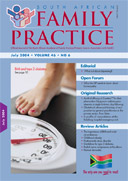Obstetrical ultrasound training of and practise by general practitioners in the private sector, Free State.
Abstract
Background: The aim of the study was to determine the level of obstetrical ultrasound training and practice of general practitioners in the Free State private sector. Methods: In this descriptive study, questionnaires were mailed to all general practitioners in the Free State private sector. The questionnaire included demographic information about the practitioner, the ultrasound profile of the practice, and the type of machine used. Results: Four hundred and eighty-one questionnaires were sent to general practitioners and 229 (47.6%) were returned. Of the 176 practising respondents, 47 (26.8%) used ultrasound. The majority of ultrasound examinations done per month were obstetrical. Eight practitioners had relevant qualifications for using ultrasound and more than a third (18, 38.3%) had no training in ultrasound use. Less than half (19, 40.4%) of the practitioners that use ultrasound were aware of the South African Association of Ultrasound in Obstetrics and Gynaecology (SASUOG). Conclusions: The response to the questionnaire was low and may have influenced the results. The study indicates that there are general practitioners who perform ultrasound examinations without training. As general practitioners mainly do obstetrical ultrasound, it is recommended that the SASUOG play a bigger role in their training. A diploma course in ultrasound and support from medical aid organisations to only pay full fees to doctors who can prove that they have sufficient ultrasound training and competence will be ideal. (SA Fam Pract 2004;46(6): 25-27)
Published
2004-07-01
Issue
Section
Original Research
By submitting manuscripts to SAFP, authors of original articles are assigning copyright to the South African Academy of Family Physicians. Copyright of review articles are assigned to the Publisher, Medpharm Publications (Pty) Ltd, unless otherwise specified. Authors may use their own work after publication without written permission, provided they acknowledge the original source. Individuals and academic institutions may freely copy and distribute articles published in SAFP for educational and research purposes without obtaining permission.

